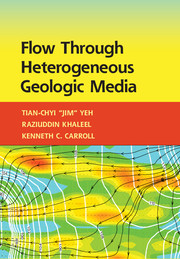Book contents
- Frontmatter
- Contents
- Preface and Acknowledgments
- 1 Fluid Statics and Dynamics
- 2 Darcy's Law for Saturated Porous Media
- 3 Darcy's Law for Unsaturated Porous Media
- 4 Stochastic Conceptualization of Heterogeneity
- 5 Governing Flow Equations for Heterogeneous Media Conceptual Models
- 6 Equivalent Homogeneous Media Conceptual Models
- 7 Flow toward a Well Due to Pumping (Part 1)
- 8 Flow toward a Well Due to Pumping (Part 2)
- 9 Stochastic Approaches
- References
- Index
5 - Governing Flow Equations for Heterogeneous Media Conceptual Models
Published online by Cambridge University Press: 05 July 2015
- Frontmatter
- Contents
- Preface and Acknowledgments
- 1 Fluid Statics and Dynamics
- 2 Darcy's Law for Saturated Porous Media
- 3 Darcy's Law for Unsaturated Porous Media
- 4 Stochastic Conceptualization of Heterogeneity
- 5 Governing Flow Equations for Heterogeneous Media Conceptual Models
- 6 Equivalent Homogeneous Media Conceptual Models
- 7 Flow toward a Well Due to Pumping (Part 1)
- 8 Flow toward a Well Due to Pumping (Part 2)
- 9 Stochastic Approaches
- References
- Index
Summary
Introduction
In this chapter, we first define the meaning of a conceptual model for analyzing flow through any geologic medium. We then classify three-dimensional conceptual models into 1) heterogeneous and 2) equivalent homogeneous conceptual models, on the basis of the control volume (CV) and representative elementary volume (REV) concepts developed in Chapter 2. Subsequently, we develop mathematical models for the heterogeneous conceptual models. Note that mathematical models for the equivalent homogeneous conceptual models are discussed in Chapter 6. To develop these mathematical models, we start with the fundamental mass balance equation for flow. Three-dimensional governing partial differential equations for flow through fully saturated media and for flow through unsaturated media are then presented. For unsaturated media, mixed-form, moisture content–based, and pressure head–based governing flow equations are introduced and their advantages and disadvantages are subsequently discussed. Combining the governing equations for flow through both saturated and unsaturated media, we then formulate the governing equations for flow through variably saturated media. Then, equations for flow through fractured rocks are presented and discussed. The auxiliary conditions necessary for deriving particular solutions to these governing equations are presented afterward.
After presenting the governing equations for various 3-D conceptual models, we devote the rest of this chapter to the development of plan-view, depth-averaged, two-dimensional groundwater flow equations. We first define depth-averaged properties, including transmissivity, storage coefficient, and depth-averaged hydraulic head. We then present a depth-averaged approach that vertically averages the three-dimensional governing equation for flow through saturated media to derive the governing flow equations for two-dimensional confined and unconfined aquifers. The effective hydraulic properties arising from the depth-averaged procedure are then introduced and are followed by a discussion of the Dupuit assumption.
Conceptual Models
A conceptual model in this book is used to refer to the way we think about how the flow through geologic media should be described qualitatively. Conceptual modelling is a necessary step before any development or selection of a quantitative mathematical model. Many different conceptual models can be developed for flow through geologic media.
- Type
- Chapter
- Information
- Flow through Heterogeneous Geologic Media , pp. 147 - 174Publisher: Cambridge University PressPrint publication year: 2015
- 1
- Cited by



